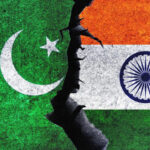Sailors, pilots and other officials are the unsung heroes of evacuation efforts
“Pin drop silence in the control room please” said the ship’s commander. We were a small group of journalists squeezed deep into the hull of the Indian Naval warship INS Mumbai, as it made its journey towards Beirut harbour in 2006. The ship had set sail along with accompanying frigates INS Brahmaputra and Betwa and the tanker ship INS Shakti from Larnaca two days before, on a mission called Operation Sukoon, to evacuate 3,000 Indians and others stuck in Lebanon after Israel declared war.
Above stairs, bunks were being emptied out to accommodate more than a thousand men and women who would board the next day, while the ship’s cavernous kitchens had vats of food on the boil to feed the guests. In the control room, the commander was communicating with Israel Defence Forces (IDF) commanders to ensure that our fleet would be given safe passage into the harbour. It was tense till the last minute, despite prior diplomatic clearances.
Like with all such evacuations, logistics can be planned, but the really big task is getting all civilians to register to board the ship. Despite the dire threat they faced, many didn’t want to leave and lose their jobs. Some had entered the country illegally, and had no papers. Officials had to work quickly against deadlines to ensure they didn’t miss their ride home.
There were other unusual moments. Many of the Indians leaving had married other foreign workers while in Lebanon, and their wives came to bid them teary farewells at Beirut harbour. When we returned with them by Air India flights from Cyprus, we were shocked to see equally teary welcomes for them from their Indian wives at Delhi airport!
In Libya and Yemen
In 2011, I watched another naval ship bearing the tricolour steam into Libya’s Tripoli; this time, I was standing at the harbour, as my cameraman and I had flown into Tripoli some days ago. With the UN’s go-ahead for NATO’s mission, it was clear that getting more 15,000 Indians working in Libya out would need a massive naval and flight operation.
The Yemen evacuation of 2015 too saw some very tricky moments, as diplomats negotiated flight windows between air raids by the Saudi defence forces on Houthi rebels who had taken over the capital, Sana’a. While journalists were not allowed to cover Operation Rahat, I remember a long conversation with naval officers who had been on board ships like the INS Tarkash from Yemen to Djibouti which evacuated nearly 5,000 Indians and other nationalities, speaking of how they had to deal with AK-47-armed Yemeni gangs who also wanted a passage to safety. After some very dangerous moments, the naval commanders negotiated to have the Indians allowed on to the ship, and agreed to take some Yemenis, after they had disarmed.
The current repatriation effort, Operation Vande Bharat, comprising operations to bring home lakhs of Indians stranded due to the COVID-19 lockdown, is certainly India’s most extensive, and involves dozens of countries; but these operations are much more orderly and far less dangerous than those that preceded it. As in the past, however, there will be hundreds of brave officials, diplomats, pilots and crew, and sailors and soldiers who will be the unsung heroes.
Rescuing Indians left stranded by war, disaster or pandemic
Sailors, pilots and other officials are the unsung heroes of evacuation efforts
“Pin drop silence in the control room please” said the ship’s commander. We were a small group of journalists squeezed deep into the hull of the Indian Naval warship INS Mumbai, as it made its journey towards Beirut harbour in 2006. The ship had set sail along with accompanying frigates INS Brahmaputra and Betwa and the tanker ship INS Shakti from Larnaca two days before, on a mission called Operation Sukoon, to evacuate 3,000 Indians and others stuck in Lebanon after Israel declared war.
Above stairs, bunks were being emptied out to accommodate more than a thousand men and women who would board the next day, while the ship’s cavernous kitchens had vats of food on the boil to feed the guests. In the control room, the commander was communicating with Israel Defence Forces (IDF) commanders to ensure that our fleet would be given safe passage into the harbour. It was tense till the last minute, despite prior diplomatic clearances.
Like with all such evacuations, logistics can be planned, but the really big task is getting all civilians to register to board the ship. Despite the dire threat they faced, many didn’t want to leave and lose their jobs. Some had entered the country illegally, and had no papers. Officials had to work quickly against deadlines to ensure they didn’t miss their ride home.
There were other unusual moments. Many of the Indians leaving had married other foreign workers while in Lebanon, and their wives came to bid them teary farewells at Beirut harbour. When we returned with them by Air India flights from Cyprus, we were shocked to see equally teary welcomes for them from their Indian wives at Delhi airport!
In Libya and Yemen
In 2011, I watched another naval ship bearing the tricolour steam into Libya’s Tripoli; this time, I was standing at the harbour, as my cameraman and I had flown into Tripoli some days ago. With the UN’s go-ahead for NATO’s mission, it was clear that getting more 15,000 Indians working in Libya out would need a massive naval and flight operation.
The Yemen evacuation of 2015 too saw some very tricky moments, as diplomats negotiated flight windows between air raids by the Saudi defence forces on Houthi rebels who had taken over the capital, Sana’a. While journalists were not allowed to cover Operation Rahat, I remember a long conversation with naval officers who had been on board ships like the INS Tarkash from Yemen to Djibouti which evacuated nearly 5,000 Indians and other nationalities, speaking of how they had to deal with AK-47-armed Yemeni gangs who also wanted a passage to safety. After some very dangerous moments, the naval commanders negotiated to have the Indians allowed on to the ship, and agreed to take some Yemenis, after they had disarmed.
The current repatriation effort, Operation Vande Bharat, comprising operations to bring home lakhs of Indians stranded due to the COVID-19 lockdown, is certainly India’s most extensive, and involves dozens of countries; but these operations are much more orderly and far less dangerous than those that preceded it. As in the past, however, there will be hundreds of brave officials, diplomats, pilots and crew, and sailors and soldiers who will be the unsung heroes.






NO COMMENT